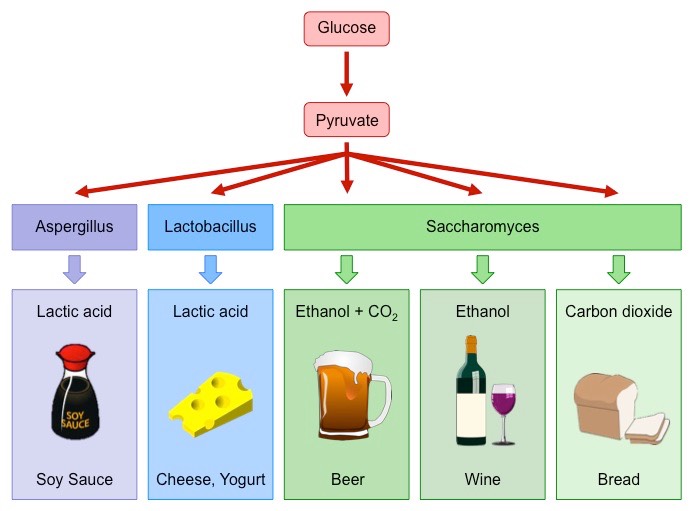F.4.1 Explain the use of Saccharomyces in the production of beer, wine and bread
- Saccharomyces cerevisiae (yeast) will undergo anaerobic respiration in the absence of oxygen to produce ethanol and carbon dioxide
- Anaerobic respiration in yeast: Glucose ð Pyruvate ð Ethanol + CO2
- This reaction forms the basis for the production of a range of food sources, including beer, wine and bread
Beer
- Barley grains are wetted in order to cause germination, which triggers the breakdown of starch to maltose – making a liquid called malt
- More water is added to make a sweeter-tasting liquid called wort, and then hops are added to give the liquid a bitter taste
- The mixture is boiled and cooled before yeast is added, which breaks down the maltose into glucose
- Fermentation by yeast produces ethanol and carbon dioxide, and the beer is finally pasteurised (heated) to kill any remaining yeast cells
Wine
- In wine production, yeast is added to crushed grapes and put into a tank, when the oxygen is consumed aerobically, fermentation occurs
- Carbon dioxide escapes from the tank while the ethanol stays behind
- The yeast cells are not killed by heat as this would affect the taste (may be killed later by the concentration of ethanol)
- Different strains of yeast produce different flavours and the strains used are capable of withstanding higher concentrations of alcohol (>10 – 15%)
Bread
- The primary function of Saccharomyces in bread-making is the production of carbon dioxide to make the dough rise
- Yeast acts on sugars in the dough, breaking them down by fermentation to make carbon dioxide and ethanol
- When the bread has risen to a desired height, the bread is baked in an oven to kill the yeast and evaporate the ethanol
Summary of the Products of Fermentation

F.4.2 Outline the production of soy sauce using Aspergillus oryzae
- Soya beans are soaked, boiled and drained before being mixed together with toasted, crushed wheat
- A culture of Aspergillus oryzae is added and the mash is incubated for 3 days at 30ºC
- Salt and water is then included before the mixture is allowed to ferment for 3 - 6 months
- At the end of this process, the mix is filtered and pasteurised, with sediments and oils removed, to make soy sauce
F.4.3 Explain the use of acids and high salt or sugar concentrations in food preservation
- Food preservation allows food to be successfully stored for longer periods of time by preventing the growth of microorganism that may feed on it
- Foods can be preserved by submerging in acid solutions – microbes cannot survive in low pH environments unless they are acidophiles
- Foods can also be preserved in high salt or sugar solutions – these are hypertonic and draw water out of the microbe by osmosis, dessicating them
- An example of food preservation using acids is pickling foods in vinegar (acetic acid), while the use of hypertonic mixtures includes the making of jam
F.4.4 Outline the symptoms, method of transmission and treatment of one named example of food poisoning
Salmonella food poisoning leads to an infection known as Salmonellosis, whereby the bacterium infects the intestinal tract
